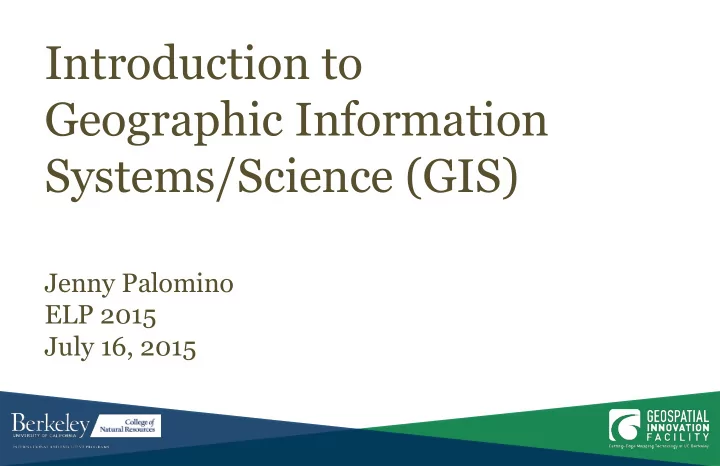

Introduction to Geographic Information Systems/Science (GIS) Jenny Palomino ELP 2015 July 16, 2015
Getting Started with GIS Fundamentals of Geospatial Analysis What is Remote Sensing? Useful (Free!) Sources of Geospatial Data Software Options for Working with Geospatial Data Easy (Free!) Web-based Options for Sharing your Geospatial Data Explore Web Applications
Fundamentals of Geospatial Analysis core spatial pattern domain questions concepts data Where are our key change location stakeholders located? persistence distance space clustering Where is the best place for a neighborhood heterogeneity new facility? time event classification spectra object Who owns land around connections national parks and how are network text proximity they using those lands? scale context accuracy How might the range of a coincidence species change in the future? Maggi Kelly, UC Berkeley
What is Spatial Data? Primary Data Types vector : point, line, polygon raster : continuous (e.g. elevation) or discrete surfaces (e.g. land use) Common Data Formats vector : shapefile, database geometry, tables (.dbf, .xlsx), KML, GeoJSON raster : ASCII, GeoTIFF, JPEG2000, MrSID, IMG, GRID, HDF5 Image: Maggi Kelly, UC Berkeley
Exploring Spatial Patterns Is the observed spatial pattern due to more than just random process? Two Measures of Spatial Autocorrelation: 1. Global - quantifies clustering/dispersion across a region a. values ~ 1.0: highly clustered b.values ~0.0: no spatial autocorrelation c. values ~ -1.0: highly dispersed 1. Local - identifies clusters (hot-spots) within the region Example in presentation is based on Moran’s I Global and Local Indicators (other indicators detailed here). http://www.pysal.org/users/tutorials/autocorrelation.html Image: ESRI help
Example of Spatial Autocorrelation Results Clustered with Global Moran's I = 0.24 Three Hot-spots/Clusters
What is Remote Sensing? Active and Passive Remote Sensing • Passive = reflected solar light… e.g. Landsat Active = an emitted energy source • is collected... e.g. lidar Maggi Kelly, UC Berkeley
Land Cover Classification Global Land Cover 2000 Project Maggi Kelly, UC Berkeley
Normalized Difference Vegetation Index (NDVI) NDVI = (Near Infrared Band -Red Band) (Near Infrared Band + Red Band) Values range from -1.0 to 1.0: water ~ -1.0 barren area ~ 0.0 shrub/grass ~ 0.2-0.4 forest ~ 1.0 http://en.wikipedia.org/wiki/Normalized_Difference_Vegetation_Index
Example of NDVI Results NDVI result from ~ -1.0 (red/orange) GeoTIFF of Landsat 8 image for the to ~1.0 (green = vegetation) San Francisco Bay Area
Useful Sources of (Free!) Geospatial Data Admin Boundaries: US Global Elevation: US Global Land Cover: US Global Protected Areas: US Global Climate: US Global http://gif.berkeley.edu/resources/data.html
Software for Working with Geospatial Data (GIS) Proprietary: ESRI ArcDesktop, MapInfo, IDRISI (low cost), Manifold (low cost) Open Source Desktop: QGIS, Grass, uDig, SAGA, gvSIG, GMT, R Spatial Packages Web-based: MapGuide (open source), CartoDB (limited free edition) Mobile: Amigo Cloud, Open Data Kit (open source), QGIS for Android (open source)
ArcMap Demonstration – Exploring the 10 mile buffer surrounding National Parks in California
Software for Working with Geospatial Data (Remote Sensing) Proprietary: ENVI, ERDAS Imagine, PCI Geomatica, IDRISI, ESRI ArcDesktop Open Source Remote Sensing Tools: Orfeo Toolbox, Grass, R, SAGA, QGIS, Opticks, OSSIM, ILWIS, Python packages (Rasterio, scikit-learn, scikit-image ) Free (but not open source) Remote Sensing Tools: – Object-based image analysis: Spring – Web-based: Google Earth Engine (currently free to Trusted Testers)
Google Earth Engine https://earthengine.google.org/#intro
Google Earth Engine
Free & Open Source Software in 2012 Steiniger and Hunter, 2013. Computers, Environment and Urban Systems, 39: 136-150
Python Image Processing: GDAL/OGR Rasterio, scikit-learn, in Python R Spatial: scikit-image rgeos, rgdal Free & Open Web-based GIS: Source MapGuide, CartoDB (limited free edition) Open Data Kit Software R tools for web and Python Spatial: in sharing: GeoPandas, R Shiny and shapely 2015 R Markdown D3 Visualization IDEs for Python: R Spatial: IPython Notebook, sp, raster, PyCharm NoSQL Spatial Databases: MongoDB, Google Cloud Datastore and Google Cloud BigTable (both cloud-based)
Easy (Free!) Web-based Options for Sharing Geospatial Data CartoDB (limited free edition): example 1 example 2 Google Maps API and Fusion Tables ArcGIS Online and ArcGIS Open Data (both open to non-ESRI license holders)
Explore Web Applications http://cal-adapt.org/
Explore Web Applications http://vtm.berkeley.edu/#/data/
Explore Web Applications http://landcarbon.org/categories/
Discussion How might spatial patterns play a role in your area of interest? What kinds of spatial analysis would be useful to explore spatial patterns in your area of interest? Based on the web applications you explored, what ideas do you have for sharing datasets and maps?
Spatial Data Science Bootcamp at UC Berkeley http://iep.berkeley.edu/spatialdatascience
Questions? jpalomino@berkeley.edu
Recommend
More recommend